Kyle Abraham/Abraham.In.Motion premieres new works at New York Live Arts.
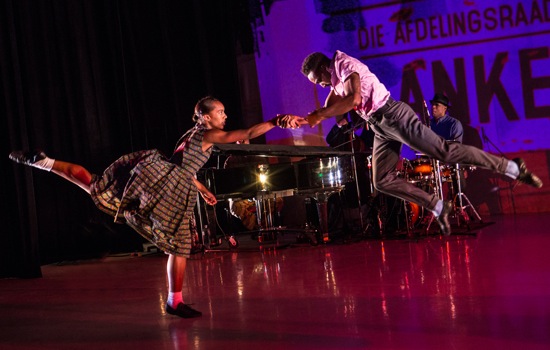
Catherine Ellis Kirk and Jeremy “Jae” Neal in Kyle Abraham’s The Gettin’. Drummer Otis Brown III visible at back. Photo: Yi-Chun Wu
You can’t really call Kyle Abraham’s rise to fame meteoric. He has been working persistently and imaginatively for around eight years. Yet few young choreographers have garnered as many awards, residencies, fellowships, and commissions as he has in the last five years. The works that Kyle Abraham/Abraham.In.Motion is showing at New York Live Arts from September 23 through October 4 were developed during his two years there as a Resident Commissioned Artist.
His choreography is a striking blend of powerful political awareness and postmodern strategies. His childhood, his family, his growing up as a gay African American man, the aspects of racism in contemporary America and elsewhere all feed into his dances—sometimes at gale force, sometimes so obliquely that you may not be sure you saw what you saw or heard what you heard.
Abraham himself is a remarkable dancer—expansive, sinuous, yet able to convey small gestural shifts that convey uncertainty, nervousness, and a host of other emotions and attitudes. In the two programs of new pieces performed at NYLA, his eight vibrant dancers cover space with big, springing, slashing steps and shifts of direction, their legs most often wide apart, reaching out. This dancing—sometimes not only big but rough—is not so much expressive in terms of the tumult surrounding and enhancing it, as it is a life-force powering the dancers along, a way of working in the world. When indecision or uncertainty or thought overtakes them, however, they most often stay rooted to a spot, a myriad of small impulses passing through their limbs and bodies. Sometimes a rhythm develops in which big and creamy moves yield to small and jittery ones and then reset to the larger scale.
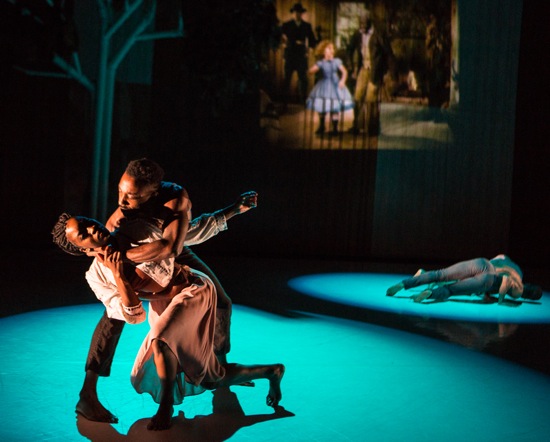
(L) Tanisha Guy and Jeremy “Jae” Neal in Kyle Abraham’s The Watershed. At back: Winston Dynamite Brown. Onscreen: Shirley Temple and Bill Robinson. Photo: Yi-Chun Wu
The Watershed, the 70-minute work that constitutes Progam A, announces some of its topics from the get-go. Three couples dance simultaneously; their themes are similar, but they are not in unison. Two women, Catherine Ellis Kirk and Penda N’diaye, partner each other; Tanisha Guy and Connie Shiau dance with men (Jeremy “Jae” Neal and Matthew Baker, as I recall). Behind them, off to the side, stands a “tree” made of white PVC pipe. Some of its branches bear wads that look like crude approximations of Spanish moss. Or stranger fruit. Film clips are projected on Glenn Ligon’s wall of variously textured wood panels. One, a sequence from the 1935 The Littlest Rebel, shows Shirley Temple as the six-year-old daughter of a plantation owner happily and expertly tapping in unison with a family slave (Bill Robinson). In another Civil-War-era scenario, Mandingo (1975), a dissolute white woman, demanding sex, slowly peels the clothes off a muscular family slave. Over and over, traffic races by a grainy image of a white cop viciously assaulting a fallen black person.
The music for The Watershed, interestingly, veers from Otis Redding to Frederick Chopin, plus Christopher Tignor, the Icelandic Band Stilluppsteypa, the Swedish BJ Nilsen, and Icelandic cellist-composer Hildur Gudnadóttir.
Occasionally Abraham inserts a vignette or a spoken or projected sentence that’s almost a cliché of racism in America. Jordan Morley hacks into pieces a watermelon that’s brought in by Winston Dynamite Brown, who wiggles his hips in anticipation. One message: don’t waste money on education for Blacks: “Can’t you see that thinking only gives them a headache?”
One powerful scene digs deeper and implies more. Abraham enters in drag— cottony white wig, white gloves, a nice dress, heels—and sits on a bench some distance from a lounging, blank-faced white man (Morley). Expertly, Abraham applies pale makeup to his face. “Please let me sit there beside you,” sings a voice. The guy attempts to lift the transvestite’s skirt; his hand is slapped away. He puts his arm around her and is rebuffed. Playing the gentleman, he kisses her gloved hand and slowly pulls the glove off. That brown male hand is more shocking than any disrobing could be. Abraham, shuddering, collapses; Morley walks away.
Images recur of people being downed and dragged away, people running. Baker chases Ellis Kirk with a lasso. Yet he also engages in a tender, athletic duet with Neal. And in the marvelous dancing by Tanisha Guy that ends the first half of The Watershed, you see resolution, bravery, and hyper-awareness of the lurking dangers, along with softness and an ease that amounts to generosity. She lets us follow the current of feeling as it flows through her dancing body.
After the intermission, the “tree” is bare, Dan Scully’s terrifically effective lighting lays beams that lie from the front to the back of the stage like the bars of a transfigured jail-cell. The dancers have shed Karen Young’s imaginative takes on plantation clothes for more stylish draped ones in grays and black. But it is to the chanting and hammer blows of a chain gang that Abraham (now in pants, but still with a pale face), dances as if he’s smoothly and evasively shifting his body inside its skin. When he finishes, a small chain falls from above. Elements from the first part of the work are repeated and varied; new ones appear (Al Jolsen onscreen in blackface but silent, the dancers ripping their costumes open to bare their backs To the lash? To reveal themselves in other ways?). At the end, Guy is still standing, while the others lie under the all-white tree.
In his “director’s note” for the program, Abraham mentions that his new works “draw inspiration” from the 1960 album Max Roach’s Freedom Now Suite. Freedom is a theme that runs through them all in various ways and alludes to various places where the Civil Rights movement was gathering force. Ligon’s blurry black-and-white projections on the back wall as Program B begins show peaked shapes that could almost be taken for Klan headdresses. Nico Muhly’s score for When the Wolves Come in at times references a church organ and becomes hymn-like in its sonorities. Drums rolls also ring out.
If that dance seems to be the most stylized in terms of statements about race relations, that may be due in part to Reid Bartelme’s costumes. Guy, Ellis Kirk, and N’diaye wear wigs shaped like curly towers that match their skimpy outfits in black, brown, or bronze. Shiau and Brown wear blond wigs. Baker and Morley dance bare-headed. But neither the presence, nor the absence, nor the color of the wigs seems to dictate behavior; Ellis Kirk and Morley sit together on the floor to rock Guy, while the music quietens. Although the significance of the headgear isn’t always clear, when Guy removes Brown’s wig, and he appears downcast, we can posit a futile and perhaps degrading futile attempt on his part to “pass for white.”
Guy is the first performer to strike a certain pose; on her hands and knees, she raises one arm, crooked like a paw—like a dog’s mutely proffered handshake. The others watch. Intermittently, over the course of the dance, they, too, assume that posture, then move on. Ellis Kirk enters crawling, led by Morley; he lets her rise to dance, then lays her out. Then she becomes a “wolf” again. In this shifting relationship, she carries him in her arms, he scrabbles on the floor, they go head to head as if to begin a fight, and, finally, he turns her upside down and drags her offstage.
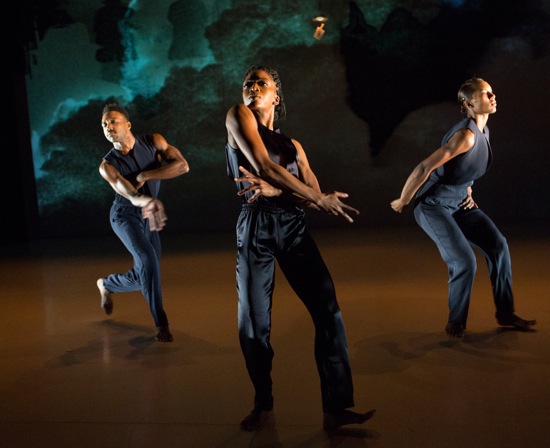
Kyle Abraham’s Hallowed. (L to R) Jeremy “Jae” Neal, Tanisha Guy, and Catherine Ellis Kirk. Photo: Yi-Chun Wu
Hallowed follows When the Wolves Came In without a pause, marked only by Neal’s first entrance of the evening. In silence, Guy and Ellis Kirk undress him and re-clothe him in black. Three lamps drop from overhead and hang, swinging slightly, from their cords. Clouds form over the hooded figures on the back wall. The profoundly simple, beautiful a capella voice of Bertha Gober fills the silence. “I told Jesus it would be all right if he changed my name,” she sings. And Neal begins to dance. Wonderfully. With those complexities that make Abraham’s movement style so arresting. Neal’s body is an unstable edifice, strong but adjusting to winds both internal and external. A hint of the wolf’s lifted paw reappears, as if in passing.
When the two women reappear, that animal motif becomes more prominent. We hear a pastor exhorting his responding flock, a woman (Cleo Kennedy) singing gospel. Strangely, toward the end the murmuring voices turn artificially high and hysterical, as if wolves had indeed “come in” yipping frantically. The dancers’ lift their “paws,” one after the other, as if slowly climbing invisible ladders to heaven.
There has been terrific dancing all along, but The Getting’ offers it to us on a golden platter. The members of the Robert Glasper Trio take their places upstage—Glasper on piano, Vicente Archer on bass, Otis Brown III on drums, and singer Charenee Wade. They start out with whacks, like the fall of a hammer, or of a whip, then start up some fine, easy jazz. Wade sings of slave days. But Glasper’s vibrant composition goes on to accent uneasiness and strife whenever those surface in the Abraham’s choreography.
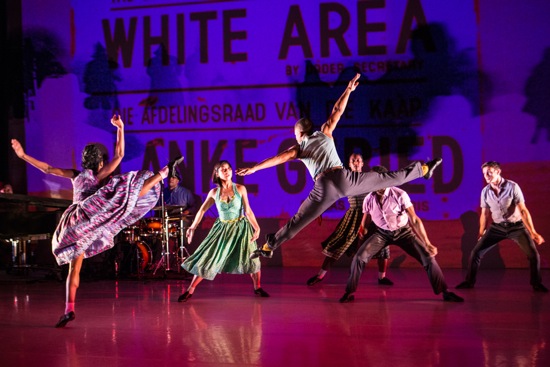
Kyle Abraham’s The Gettin’. (L to R): Tanisha Guy Connie Shiau, Winston Dynamite Brown, Catherine Ellis Kirk, Jeremy “Jae” Neal, Matthew Baker. Photo: Yi-Chun Wu
The dancers wear individualized outfits by Young—the women’s printed cotton dresses evoking the 1950s, the men in pants and casual tops. Some of the images that appear, superimposed on Ligon’s blurred back wall, are “White area” signs from South Africa in English and Afrikaans. So, yes, Abraham is still evoking the fights for freedom worldwide. While grainy shots of police incidents flash by, Wade yells, and Baker and Neal pull down their shirts to show their bare backs. Small, valiant Guy is wrestled offstage.
But the dancing itself is a tornado. It swirls around, touches down, blows away, and returns with renewed vigor. Six spirited, powerhouse dancers (Baker, Brown, Guy, Ellis Kirk, Neal, and Shiau) meet, mingle, hustle off). The duet for Baker and Neal is a high point. The music and the images on the wall may rage, but the men keep dancing as long as they can—first a little suspicious of each other, then in harmony, determined to stay in synch and to succor each other. Shiau performs a wonderful, richly variegated solo, filling more than just the space around her. The end is strangely jolting. Drums sound alone, red lights cool down while Guy jitters then gets with the beat. A voice speaks: “I am my own nigger joke,” as the curtains slowly close, and the music gradually ends.
Abraham attempts to accomplish so much in these dances. He spreads a banquet of ideas through music, visual effects, words, and, above all, dancing that contains a rich supply of information about how humans convey strife, heroism, vitality, and persistence. As a director, he wants, I think, to deconstruct the grim realities—to pin them to the wall without enacting them, to scatter vivid scraps of narrative, deprived (in most cases) of follow-up. I suspect he’s afraid of being too obvious in how he presents his volatile subject matter. I’m for that, but it means that weak connections crop up here and there, keeping us in a mental spin. I drink it all in anyway, acknowledging that Abraham has dared to tackle a huge, explosive issue and admiring all that he has achieved.

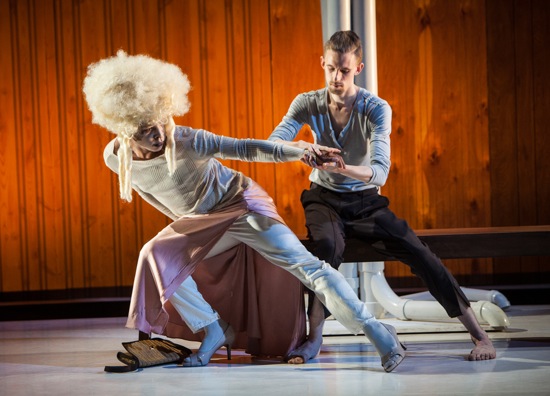
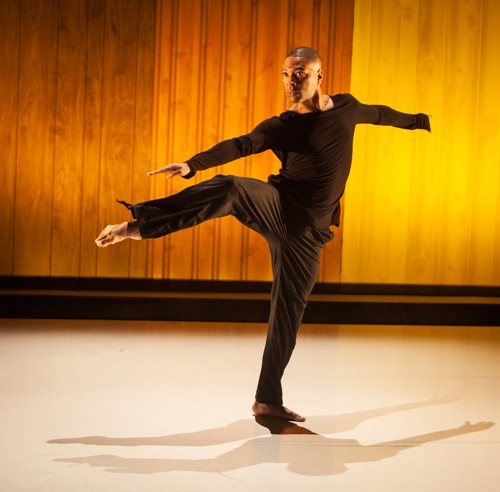
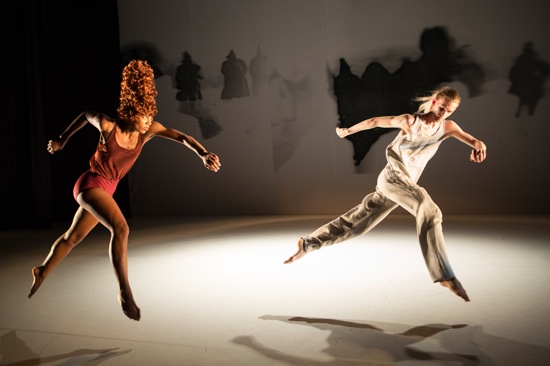
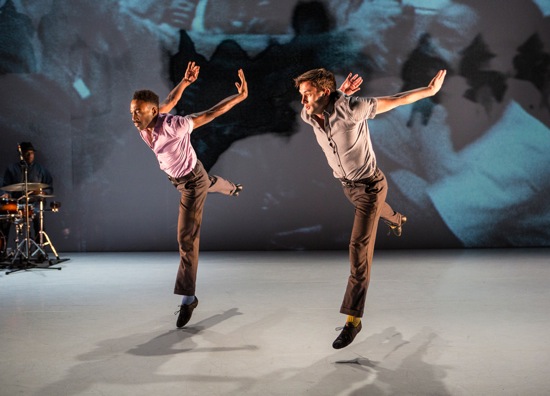
I read this with great interest and am hoping that we will see the same program when Abraham comes to Ann Arbor in the winter. I’m afraid I haven’t seen enough of his work to get a really solid sense of it but your review helps. What I’m really curious about would be to get a sense of his movement and overall choreography in relationship to other choreographers (past and present) — perhaps that is impossible. The pictures give you some idea, but not enough for me. I know this isn’t in your purview as a critic — but as I respect your opinion so much — and as I know you have the wide historical context in which to place him, I’m really curious. i get the sense that you think that the dancing is wonderful to watch — full bodied and luscious — but I don’t get the sense of a distinctive choreographic personality. Maybe that is too much to ask at this point — and maybe I haven’t read it carefully enough, but I’m really looking forward to what you eventually say about this.
One of the really difficult things to deal with here I think is the political content of it all. In my own case, I find it difficult in writing about some choreographers to distinguish between having an opinion about the aesthetic merit of it all and the political content. Often I find that I support the political commentary, but am not so thrilled by it all aesthetically. ( I have that problem with Bill T. Jones sometimes.) Maybe that will be possible when we all become a more enlightened society that has wiped out the racism that is still so much a part of us all.
I am grateful for Beth Genne’s thoughtful response to my review. It made me realize that I hadn’t mentioned a component of Kyle Abraham’s movement style. While growing up in Pittsburgh as a student of the cello and a burgeoning dancer, he was observing city-streets forms and exploring the variants of hip-hop. The interplay of the staccato and the legato in his choreography and the complex ways in which jabbing contests and joins undulating in the bodies of his dancers attest to that influence.